Hi everyone, Great class this week. I was pleased by what everyone did. For homework, you will have to do some drawing and start on the Mid-Term Animation. You do not have to complete it and what you do have to do does not have to be perfect. What I want is for you to try your best on the animation. We will clear up any difficulties or mistakes you make in class next week. What I do want is for you to spend a lot of time on your drawings to make certain they are nice. Have a nice weekend, Carter-
- TOPICS:
- HOMEWORK: Over the next week, we will begin working on your mid-term projects. Please read all the handouts about scripting and storyboarding listed below. I will discuss them in more detail in the next class.
- Due by NEXT week:
- Flash Drawing—You must read the downloads for the Snowman animation. Then, you should create the landscape for this animation which should include the following: the ground, the mountains, a snowman, a sun, some clouds, and a tree. Since this class is an animation course, we will be creating a couple animations, one due on the last day of class, and the other due at mid-term, week 6 or 7 of the term, which is only 3 or 4 weeks away. This is not much time really, so please do not get behind. The more time you give yourself the better your work will be. Creativity is always rewarded in this class, so free yourself and your mind, be experimental and adventurous.
- also Due NEXT week:
- Animation—You must begin experimenting with your animation. I know that I have not demonstrated how to begin this yet, but you should try doing yourselves on your own nonetheless. EXPERIMENT and try to figure out for yourself. It is all right if you do not succeed. I like to see when people make attempts even if they don't work out; but you do have got to put some time into it if you want to succeed, and there's no time like the present. Read the first paragraph of the Snowman Story and complete this part of the animation by next week. This must occur in the scene that you draw for this week's homework.
- Links for the mid-term project—You will see several links below. The FIRST one is the most important. The others that follow are for additional information. If you wish, you may create a storyboard first for the Snowman Story. If so, read all the downloads for guidelines on doing this. EVERYONE will need to read the first download, The Snowman Story:
- Due by NEXT week:
- SIMPLE DRAWING EXERCISES:
- Creating a simple Graphic Symbol:
- Once you draw your cloud or tree, it should be converted to a symbol (F8) like many of the other much more simple objects we have draw thus far, ovals and rectangles mostly.
- To do so, after you have drawn your cloud, for instance, you must choose the selection tool (V) and select the entire cloud.
- Then select F8, convert to symbol.
- Give it the name cloud, select graphic for behavior and then click okay.
- Now you will see that it has a blue box around it when it is selected. If you de-select by selecting escape or by clicking on the background somewhere, you will see the blue box disappears.
- One thing you should remember is that since the cloud is now a symbol, you must not double-click on it, as this will take you into symbol-edit mode for the cloud.
- If you do wish to edit your symbol, then do double-click on it; however, you must remember to exit symbol-edit mode by clicking on Scene 1 in the upper-lefthand corner of the window.
- If you select F11 or ctrl-L the Library will open up. To close, you simply select F11 orctrl-Lagain. Once open, you will see a smaller representation of your circle symbol there. If there are more symbols, you will see them all listed there. Here is where your symbols are stored. What is on the stage is known as a symbol instance. It is like a clone, or a copy of what is in the library. Symbol instances may be deleted from the stage without affecting the symbol in the library. However, take great care of your symbols in the library. Do not delete the symbols from the library if you are using them in your movie. If you delete the symbols in the library, they will also be deleted from the entire movie.
- You may use as many symbol instances as you need. All you need to do is drag an instance from the library onto the stage.
- After you draw the tree, you should do the same and convert it into a symbol too (F8).
- Creating a Simple Landscape:
- If you haven't drawn your tree or cloud yet, or if you have not yet converted them into symbols, then look at the above exercise to do so first: LINK
- Once you have created your symbols, make sure that for now you have only one instance of each of them on the stage. Click one time on the tree and cloud to make sure they are symbols. If the blue box appears around them when they are selected, then they are probably symbols. Next, look in your library (ctrl-L) and make certain both symbols are there. If so, then you're all set, so delete both of them from the stage, but careful not to delete them from the library.
- Next, in the timeline, double-click where it says layer 1 and type the name ground
- Then, choose the rectangle tool (R) and draw a rectangle over the bottom part of the stage. Adjust the fill and stroke colors of the rectangle if you need to.
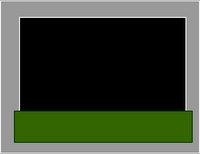
- Manipulating Layers:
- Creating a simple Graphic Symbol:
- Foreground & Background: When objects are placed in a landscape, to give the illusion of depth, they take on different sizes. Objects that are far away from the viewer, the camera, appear smaller. Objects that are nearer appear larger. To convey this relative size and relative distance, the free-transform tol (Q) is used to resize an object such as trees that are either further away or closer to the camera.
- Add a new layer and name ittree-near.
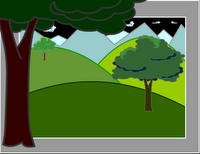
- Open the library (ctrl-L or F11) again, and drag another instance of the tree symbol onto the stage.
- Again, use the free-transform tool (Q)to resize the tree until it is much larger. It should hang off the edges of the stage significantly. Place it so that it rests along the left edge.
- Next, select this tree on the stage using the selection tool (V), open the properties bar, and click where it says color and select brightness. Make the tree darker as it is nearest to the viewer.
- Now, lock the tree-near layer.
- Open the library (ctrl-L or F11) once again, and drag a third instance of the tree symbol onto the stage.
- Use the free-transform tool (Q)to resize the tree until it is much smaller. Place it so that it rests on one of the background hills.
- Add a new layer and name ittree-near.
- Dim, Hazy Distance: To further provide an illusion of distance, objects that are further away from the viewer, from the camera, appear dimmer or lighter or hazier. This is due to the effects of the atmosphere and water-vapor. Color and symbol effects may be used to help provide this effect.
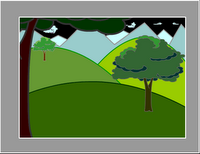
- Select this smallest tree on the stage using the selection tool (V), open the properties bar again, click where it says color and select brightness. Make the tree lighter as it is furthest from the viewer.
- Save and test (ctrl-enter) the movie, and it will look like the following image.
- Finally, you may also add these effects to the clouds, making them lighter, or, perhaps somewhat transparent with alpha.
- Save and test (ctrl-enter) the movie, and it will look like the following image.
- Fish Drawing

- Gradients

- Now let's apply some color to our background using linear gradients. A gradient is a gradual change from one color to another. First, using the rectangle tool (R), draw a rectangle for the ground. It is all right whatever color you choose for now, because we will change it with the gradients. Also, the rectangle should hang over the edges of the stage some. Don't try to draw exactly to the edge of the stage.
- After you draw the first rectangle, draw a second one for the remander of the background. The color for this one will also be altered by the gradients.
- Next, open the color mixer panel.
- Notice in the panel where it says solid. Click there and select linear, and then next notice the horizontal line below that appears. It represents the gradient, and by default goes from black to white.
- The gradient colors can be changed by manipulating the square boxes below the horizontal line. To change the color of one of them, simply double-clip on it and the color selection panel appears.
- Choose a color that you like, and the gradient is altered. If you double-click on the other box, you can select its color also.
- Use the paint bucket tool (K) to fill the bottom rectangle with the gradient, and the fill transform tool (F) to rotate it so that it goes from light to dark from bottom to top.
- Repeat the previous 4 steps for the top rectangle.
- This will be the background of your animation, so name the first layer backgound and lock it.
- Add a new layer and name it fish.
- Place the fish graphic symbol that you created in this layer.
- Moving the Fish:
- On the stage, move the fish symbol to the middle of the right side of the stage.
- In the timeline, click in frame 20 and add a keyframe (F6).
- On the stage, move the fish to the center of the stage.
- n the timeline again, click in frame 40 and add another keyframe (F6).
- On the stage again, move the fish to the left-hand side of the stage.
- Now, place the arrow between frames 1 and 20, right-click, and select Create Motion Tween.
- Finally, place the arrow between frames 20 and 40, right-click, and select Create Motion Tween again.
- The final fish animation is here: LINK
- To add the easing click here: LINK
- Motion Tween Easing
- Motion Tween Easing is a tool that is used to alter the speed of an object through a motion tween. As in the fish animation above (and here), the fish slows down toward the middle, and then speeds off again, as if swimming against the rhythmic current of the ocean waves.
- Returning to the fish lesson, click in the middle of the first tween in the timeline, that is between frame 1 and frame 20 in the lavendar area.
- Next, open up the properties bar, locate the ease setting, click there, and select 100. This will cause the fish to slow down at the end of the tween.

- Then, click in the second tween between frame 20 and frame 40, look in the properties bar again, and set the ease to -100. This will cause the tween to start slow and speed up toward the end of the tween.

- SNOWMAN ANIMATION: Below, you will see a review the first step of the snowman animation as it is described in the first paragraph of the Snowman story and as we started 2 weeks ago. Notice two things: first, how many layers there are and what their names are; second, how many frames each part of the animation takes. Remember, the lavendar areas are the motion tweens.
- Create your first layer and name it mountains.
- In this layer, draw the two mountains in the background as described in the Snowman Story.
- Now lock this layer.
- Create a new layer and name it ground.
- In this layer draw the ground in the foreground where the snowman will be standing.
- Now lock this layer too.
- Create a new layer and name it snowman1.
- In this layer, draw the large circular snowball that will form the parts of the snowman. You may use any tools you wish to do this. I used the brush tool (B) to make mine because I didn't want it to be an absolutely perfect circle as the oval would probably have done. I then created a radial gradient and used the paint bucket (K) tool to fill it up. Afterwards, I selected the brush tool (B) again and made some marks to make the snowball seem irregular.
- Once you complete your snowball, select the entire thing and convert it to a symbol (F8).
- Give it the name snowball, select graphic for type, and then click okay.
- Place the snowball symbol off the stage to the right-hand side.

- Choose the free transform tool (Q) and make the snowball a little bit smaller. To do this, remember, you must hold onto the shift key and drag on one of the corner handles.
- Now, in the timeline in the snowman1 layer, click in frame 1 and then release.
- Once you release, click again and hold down. Before you let go, drag it to frame 10 and then release. This will move the keyframe to that frame, frame 10.
- Next, since the part of the animation in which the snowball rolls into the stage is supposed to take one and a half seconds (check the Snowman Story), this means that it should take 18 frames. Recall, the frame rate is 12 frames per second. This means for one second there are 12 frames of animation. Therefore, if you need 1 1/2 seconds of animation, you need 18 frames. I altered this a little and made it 20 frames in my animation. What you should do next, then, is to click in frame 30 of your animation in the snowman1 layer and add a keyframe (F6).
- Now, move the snowball to a position on the stage somewhere in the middle.

- Make the snowball larger now using the free transform tool (Q).
- Once you have done this, in the timeline between the keyframes in the gray area, right-click and select create motion tween.
- Then, click somewhere in the timeline in the lavendar area of new motion tween.
- Open up the properties bar and locate where it says rotate.
- Since the snowball is moving to the left, we want it to rotate in the counter-clockwise direction, so select CCW, and the number of times it should rotate is one.

- Next, click in frame 35 of each layer one at a time and extend the duration (F5).
- Lock the snowman1 layer, add a new layer, and name it snowman2.
- Click in frame 35 of this layer and add a new keyframe (F6).
- From the library (F11 or crl-L), drag an instance of the snowball symbol onto the stage off to the right side like the first one.
- Make this snowball even smaller than you did the first one.

- Next, click in frame 55 of this layer, and add a keyframe (F6).
- Move the smaller snowball next to the first one and then make it a little larger.

- Now add your next motion tween between those two keyframes, frames 35 and 55.
- You should also make this rotate CCW and one time.
- In the next eight (8) keyframes we will use a frame-by-frame animation that lifts the second snowball onto the first and then makes the two snowballs squash down and back up. So, click in frame 56 and add a keyframe (F6).
- Now, lift up the second snowball and move it upwards slightly and a little to the left.
- Then click in frame 57 and add a keyframe (F6).
- Repeat this action 2 more times for frames 58 and 59.




- The next four frames follow the squash and stretch effect of the weight of the second snowball as it comes to rest onto the first snowball.
squash it down a little:
 squash it down a little more:
squash it down a little more:
 make them taller again, even taller than they started as a kind of bounce back:
make them taller again, even taller than they started as a kind of bounce back:
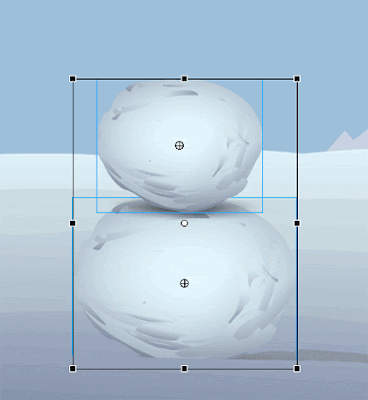 put them back to their original size:
put them back to their original size:



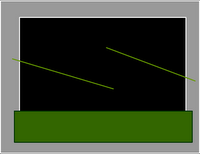
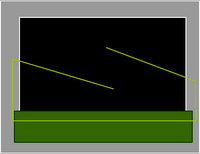
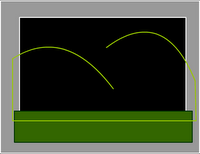
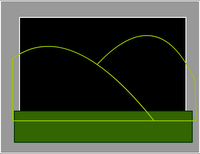
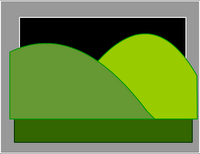
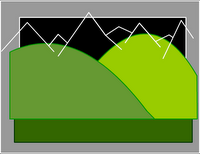
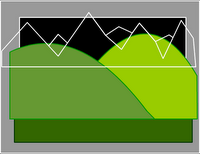
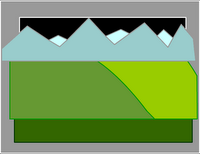
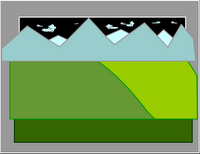
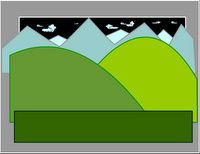
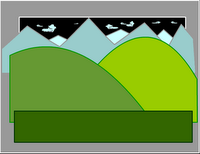
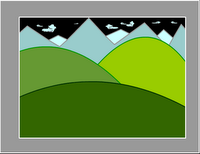

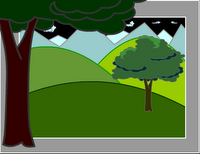
No comments:
Post a Comment